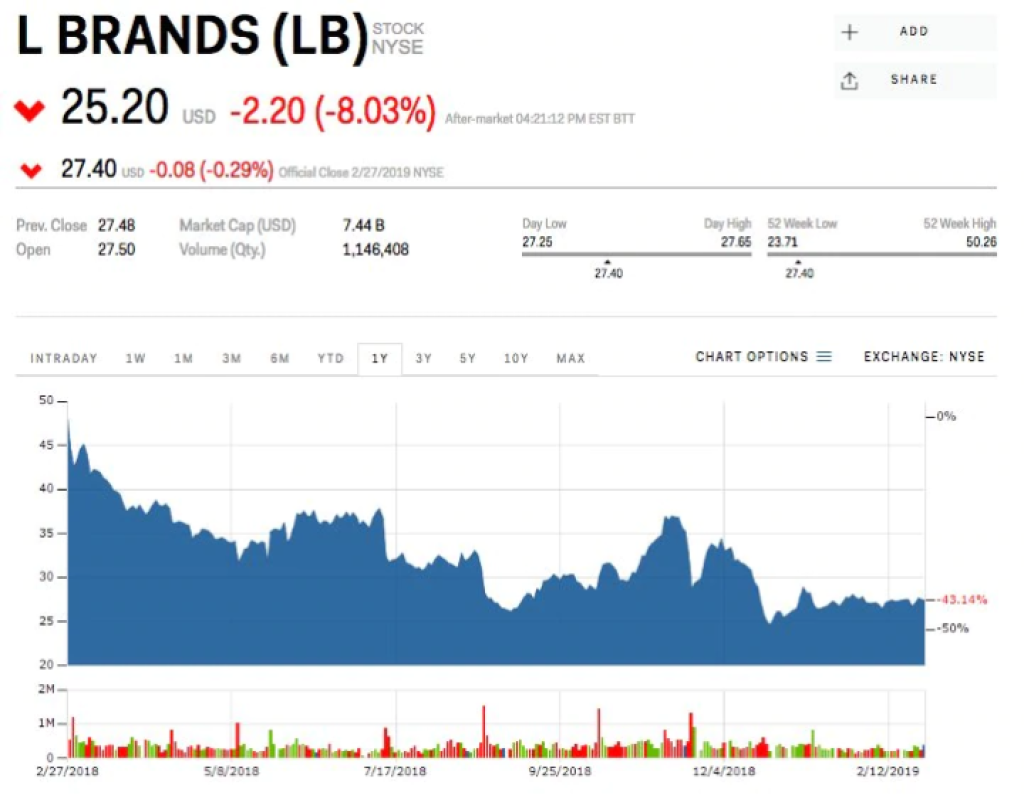Remember when Victoria’s Secret was on top of the world? Two years ago, the brand staged a fashion show in Shanghai, China, that engaged some 1bn people in 190 countries across the globe. A year later, the brand’s blockbuster fashion show tanked spectacularly, so much so that the brand’s premier event has been cancelled indefinitely, as the brand owners have a ‘rethink’ about this global event.
Bloomberg smartly summarised the brand’s key challenge in a headline that tells you pretty much everything you need to know about where the brand is at right now: “Victoria’s Secret Is Still Advertising to Women Like It’s 1999.”
Bottom line
Now let’s look at the brand’s bottom-line performance.
You don’t need to be an economist to understand what’s happening at L Brands, the US-based fashion retailer that owns Victoria’s Secret, its flagship brand. The share-price trajectory shows a strong decline. Summing up the brand’s woes, financial and investor news service Barron’s had this to say: “L Brands stock (LB) has been in free fall after sales reports showed that its Victoria’s Secret brand was resting on what was once sexy. Padded bras and ‘angels’ aren’t appealing to customers now as they did in the 1990s. Merchandise margins thinned as management reached for discounting to clear out inventory instead of pivoting to meet changing underwear preferences. Mistakes, compounded. Sales did not.”
This should come as no surprise to L Brands because, as far back as 2008, it had access to profound contextual insights that would have saved the owners of Victoria’s Secret a whole lot of pain and loss, if the sage advice offered by the writers of a study on how the world has changed had been heeded.
The analysis, called “Victoria’s Dirty Secret: How Sociocultural Norms Influence Adolescent Girls and Women”, produced by academics at Wilfrid Laurier University with the University of Waterloo in Canada, stated: “Women’s body dissatisfaction is influenced by sociocultural norms for ideal appearance that are pervasive in society and particularly directed at women.”
Flawed metric
How the media and social norms affect young people was thrown into sharp focus for me after I had my first child — a daughter. I feel more strongly than ever that the norms created by brands, advertisers and the media shouldn’t tell women to devalue their bodies, attractiveness or physical appearance. Certainly, and obviously, physical appearance is a flawed metric for valuing a human. This has created a world where girls as young as eight or nine are dieting, and feel they’re not ‘pretty’ enough.
The advertising industry has helped create this problem and, having recently been appointed to a leadership position in this sector I feel profound accountability. We have to find a new way to market to women. We can’t have our daughters comparing themselves to unrealistic ideals, and encouraging an industry that relies on objectification and stereotyping. We can absolutely tap into human truths to connect with our consumers, but we need to acknowledge that we are responsible for young minds.
We must challenge ourselves to find better role models for our young girls, so that they grow strong and confident. In my book, the dignity, strength and intelligence of a Caster Semenya outclass what Kendal Jenner can teach a girl child any day of the week.
Strong human values are so much more worthwhile communicating. Victoria’s Secret will only begin to improve once it fully appreciates this archetypal human truth.
